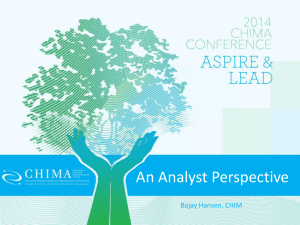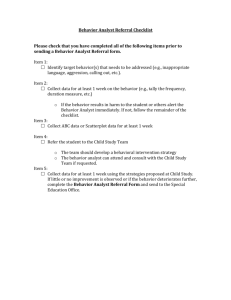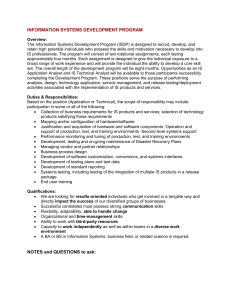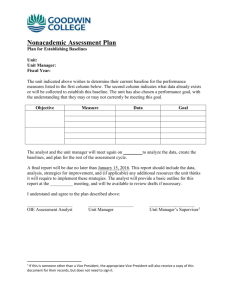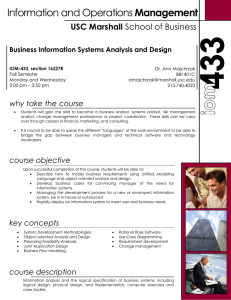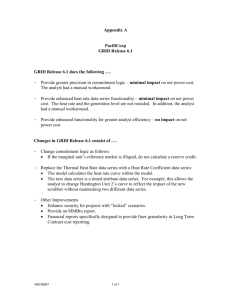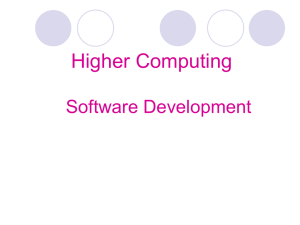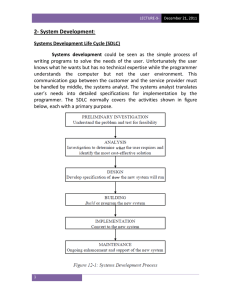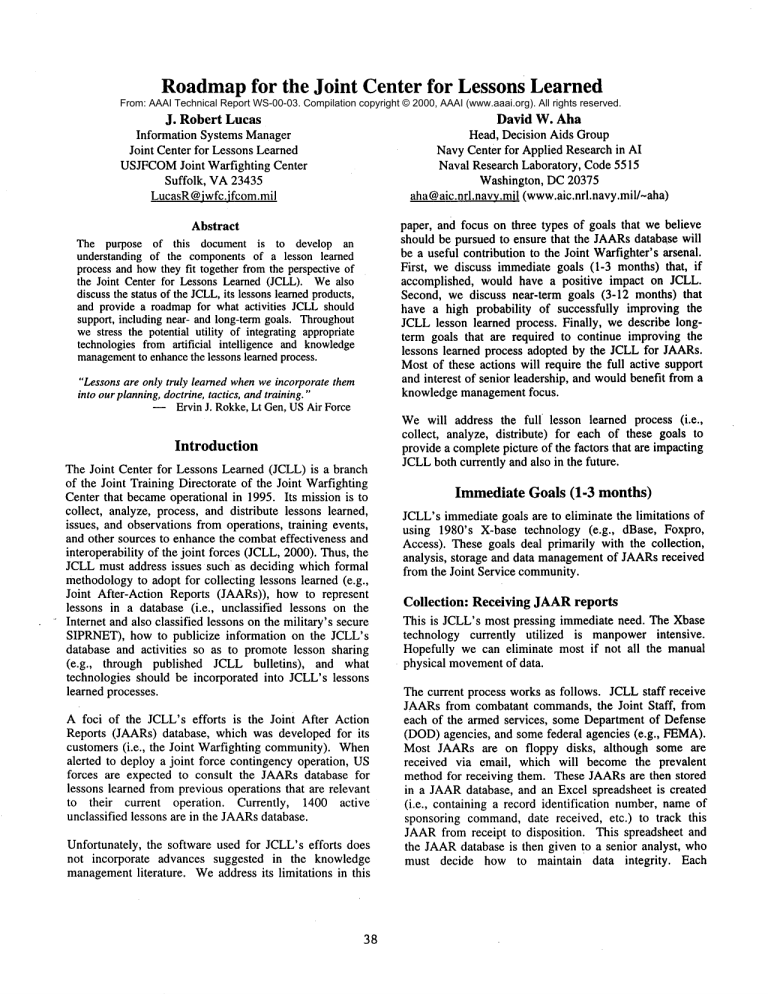
Roadmapfor the Joint Center for Lessons Learned
From: AAAI Technical Report WS-00-03. Compilation copyright © 2000, AAAI (www.aaai.org). All rights reserved.
David W. Aha
Head, Decision Aids Group
Navy Center for Applied Research in AI
Naval Research Laboratory, Code 5515
Washington, DC 20375
aha@aic.nrl.navv.mil (www.aic.nrl.navy.mil/~aha)
J. Robert Lucas
Information Systems Manager
Joint Center for Lessons Learned
USJFCOM
Joint Warfighting Center
Suffolk, VA23435
LucasR @jwfc.ifcom.mil
Abstract
The purpose of this document is to develop an
understanding of the componentsof a lesson learned
process and howthey fit together fromthe perspective of
the Joint Center for Lessons Learned (JCLL). Wealso
discussthe status of the JCLL,its lessonslearnedproducts,
and provide a roadmapfor what activities JCLLshould
support, including near- and long-term goals. Throughout
we stress the potential utility of integrating appropriate
technologies from artificial intelligence and knowledge
management
to enhancethe lessons learned process.
"Lessonsare only truly learned whenwe incorporatethem
into ourplanning,doctrine,tactics, andtraining."
-- Ervin J. Rokke, Lt Gen, USAir Force
Introduction
The Joint Center for Lessons Learned (JCLL) is a branch
of the Joint Training Directorate of the Joint Warfighting
Center that becameoperational in 1995. Its mission is to
collect, analyze, process, and distribute lessons learned,
issues, and observations from operations, training events,
and other sources to enhance the combat effectiveness and
interoperability of the joint forces (JCLL,2000). Thus, the
JCLLmust address issues such as deciding which formal
methodologyto adopt for collecting lessons learned (e.g.,
Joint After-Action Reports (JAARs)), how to represent
lessons in a database (i.e., unclassified lessons on the
Internet and also classified lessons on the military’s secure
SIPRNET),how to publicize information on the JCLL’s
database and activities so as to promote lesson sharing
(e.g., through published JCLL bulletins),
and what
technologies should be incorporated into JCLL’s lessons
learned processes.
A foci of the JCLL’s efforts is the Joint After Action
Reports (JAARs) database, which was developed for its
customers (i.e., the Joint Warfighting community). When
alerted to deploy a joint force contingency operation, US
forces are expected to consult the JAARsdatabase for
lessons learned from previous operations that are relevant
to their current operation. Currently, 1400 active
unclassified lessons are in the JAARsdatabase.
Unfortunately, the software used for JCLL’s efforts does
not incorporate advances suggested in the knowledge
management
literature. Weaddress its limitations in this
38
paper, and focus on three types of goals that we believe
should be pursued to ensure that the JAARsdatabase will
be a useful contribution to the Joint Warfighter’s arsenal.
First, we discuss immediate goals (1-3 months) that,
accomplished, would have a positive impact on JCLL.
Second, we discuss near-term goals (3-12 months) that
have a high probability of successfully improving the
JCLLlesson learned process. Finally, we describe longterm goals that are required to continue improving the
lessons learned process adopted by the JCLLfor JAARs.
Most of these actions will require the full active support
and interest of senior leadership, and wouldbenefit from a
knowledge managementfocus.
Wewill address the full lesson learned process (i.e.,
collect, analyze, distribute) for each of these goals to
provide a complete picture of the factors that are impacting
JCLLboth currently and also in the future.
Immediate Goals (1-3
months)
JCLL’simmediategoals are to eliminate the limitations of
using 1980’s X-base technology (e.g., dBase, Foxpro,
Access). These goals deal primarily with the collection,
analysis, storage and data managementof JAARsreceived
from the Joint Service community.
Collection: Receiving JAARreports
This is JCLL’s most pressing immediate need. The Xbase
technology currently utilized is manpowerintensive.
Hopefully we can eliminate most if not all the manual
physical movementof data.
The current process works as follows. JCLLstaff receive
JAARsfrom combatant commands,the Joint Staff, from
each of the armed services, some Department of Defense
(DOD)agencies, and somefederal agencies (e.g., FEMA).
Most JAARs are on floppy disks, although some are
received via email, which will become the prevalent
method for receiving them. These JAARsare then stored
in a JAARdatabase, and an Excel spreadsheet is created
(i.e., containing a record identification number,name of
sponsoring command,date received, etc.) to track this
JAARfrom receipt to disposition. This spreadsheet and
the JAARdatabase is then given to a senior analyst, who
must decide how to maintain data integrity.
Each
reviewing analyst is given a copy of the entire working
JAARdatabase, although edits can only be made to the
senior analyst’s copy. Finally, the JAARdatabase is
divided into parts for each reviewing analyst so they can
edit their respective parts. Afterwards, these parts are recombinedwhenthe review process is completed.
format conversion process and then imported into
DbtextWorkbefore analysts can performfull text search..
Each of the three basic analytical processes requires a
slightly different set of search capabilities:
A more desirable collection process would import the
JAARsto a central database, which would facilitate
performing the remaining collection and data management
processes seamlessly. Also, this process should be
modified so that lessons can be collected in any format
(e.g., MSWord, AmiPro,Email). This will require storing
JAARs in such a way that someone conducting an
analytical search (see next section) can understand
document’s history and context. These are issues that the
JCLLcan examine by collecting and storing all of the
JAARsthat it has received. To organize this information,
the JCLLmay benefit from using tools provided by the
Joint Digital Library System (JDLS, 2000). The objective
of this effort is minimize user search time and maximize
user analysis results.
To ensure that collection can be easily performed by
individuals in the field with no access to a network,
WinJIIP (WindowsJoint Instructional Input Program), or
similar program, should be used. Furthermore, the
capability to provide lessons learned information in dBase
format must be maintained, and the collection software
must also be compatible with the Joint Training
Information ManagementSystem (JTIMS) (i.e., because
lessons need to be gleaned from the Joint Training
community).
Analysis
The purpose of analysis is to organize and evaluate
information to identify lessons of Joint Service
significance. The desired collection process described
above, if implemented,wouldsignificantly reduce analysis
problems.
Analysts focus on the benefit that JAARscan provide by
accurately retrieving JAARrecords of interest.
The
primary attributes of interest in a JAARare narrative
paragraphs, which are all unstructured free text. To
accurately retrieve JAARrecords, the analyst needs a
search tool that can perform full text searches. This
capability would also allow JCLLanalysts to evaluate
information so as to identify lessons of "Joint Service
significance," and to meet JCLL’smission responsibilities
for disseminating lessons learned to any Joint Service
member.
JCLLcurrently utilizes a commercial program, InMagic,
Inc.’s DbtextWork,that provides the ideal set of full text
search features. However,data must be put through a data
39
1.Joint Service submitted JAARreview process. The
objective of this process is to ensure each re, cord’s
completeness, minimumquality standard, and to
identify up to three related tasks from the Universal
Joint Task List (UJTL). First, individual JAAR
records should be selected for review and editing, if
necessary. The system should support several
different selection indices (e.g., sponsoring command,
UJTL task entries; English phrase contained in
narrative paragraphs). Second, the analyst should be
able to mark each JAARrecord with data management
information (e.g., stage in processing, dates of receipt
and start of processing stage, record disposition).
Third, a completed JAARrecord should become
locked except by special request to the JCLLsystem
administrator, whocould permit a specific person to
make changes and then re-lock editing. Fourth,
analysts should be able to print selected JAAR
records. Finally, the system administrator should be
able to easily generate data management
reports.
,
JCLL’s analysis of JAAR databases and other
information repositories. The objective of this process
is to identify lessons from any source that is available,
and to makeidentified lessons available to the entire
Joint Service Community.Searches will be primarily
unstructured text phrase matching searches, requiring
a full-text search tool that must support saving the
search criteria and results set and then expanding or
narrowingthe results set if desired.
3. Joint Service memberanalysis of JAARdatabases and
lesson learned information repositories.
The WWW
allows users to access remotely located information
repositories. However,existing WWW
search features
are limited. Currently both JCLLanalysts and Joint
Service members can search JAARdatabases online.
Because this database depends on antiquated
technology, the probability of a user finding relevant
lessons is small. JCLL’sinformation systems analyst
should work closely with JDLSsystems engineers to
identify how to use JDLStools (e.g., the Ontology
Mapping Engine (OME)) to manage documents in
JAARsdatabase, and to develop search capabilities
that improve precision and recall for Joint Service
members.
Distribution
This sub-process concerns sharing lesson learned
information with all Joint Service members.It is the most
difficult sub-process to viably accomplish,yet is crucial to
all other (i.e., collection and analysis) efforts. It is
commoncomplaint from most "lessons learned" associated
organizations that the current process is not achieving the
results needed.
The current philosophy being employedin distributing or
sharing lessons learned is "Build it and they will Come"
(Kinsella, 1996) (i.e., from the popular movie FieM of
Dreams)..The problem is, if you don’t knowit is there,
you won’t find it. The reason for this is that there is so
muchinformation available electronically or otherwise that
a user does not have time to sift through all the superfluous
information to find the relevant information.
The current methods JCLL employs does provide some
benefit, but not anywherenear what is required to ensure
the required readiness of Joint Forces in this era of the
"Information Age." For an organization to effectively
learn lessons, manyprocesses must take place so that the
right information gets to the right person at the right time.
This requires changing JCLL’s distribution philosophy.
Instead of organizations building an information entity
which information seekers must locate and search to try to
identify relevant information, they should instead build an
information fusion system that users can access anywhere,
and which can automatically locate information relevant to
a user’s interest. Weterm this concept user on-demand
learning.
JCLLis providing the Naval Research Laboratory’s (NRL)
Intelligence Decision Aids Group with lessons learned
information on non-combatant evacuation operations
(NEOs). NRLis using this information to demonstrate
user on-demandlearning capability for extracting relevant
lessons learned in their HICAPplan authoring software
(Weber et al., 2000). HICAPprovides a generic set
tasks that should be considered to execute a NEOmission.
It then interactively walks a user through a series of
questions to tailor the task list to a given mission. HICAP
allows the decision-maker to completely disregard the list
or modify it in any way. During plan construction, HICAP
prompts users with collected lessons if their conditions
closely match the conditions of the plan being constructed
for the current mission.
Near Term Goals
(3-12
months)
JCLL’snear term goals are to complete the evaluation of
relevant software tools provided by the JDLS, including
the OME,and to implement promising processes and
capabilities
identified during this evaluation, and
subsequent experimentation, that can contribute to JCLL’s
needs.
40
Collection
An important objective of this experimentation is to
expand the collection of information beyond JAARs.One
of the primary obstacles to having a viable lessons learned
program is the lack of volume and quality information.
One reason for this is that submitting a JAARrequires
someoneto invest a significant amountof time learning
howto use the required JAARsoftware and then spending
the time to input information into the form.
With the capabilities
of the JDLS, JCLL can allow
operational personnel to submit text versions of the afteraction report instead of requiring themto rewrite it in the
manypieces that are required to fit in the dBaseformat of
WinJIIP software. Collecting the text versions of a
submitter’s after-action report reduces their workloadand
increases the quantity and quality of information for JCLL
and, therefore, the Joint Services.
This solves one problem but introduces others: howdo we
structure the storage of information so that a user can
identify and retrieve only the information that they are
interested
in and need? JCLL perceives the OMEas
providing great potential in creating an information storage
capability that will facilitate and ease the retrieval of
relevant information.
Analysis
Hopefully, the capabilities that the OME
provides will lay
the foundation for satisfying relevant information retrieval
requirements. The first step towards retrieving only
relevant information is to limit the results of a search to a
specific segment of a document rather than the entire
document. For example, suppose a user conducts a search
using a specific knowledge set phrase (OMEand HICAP
will facilitate this capability) that yields a result table
listing 10 documentsas having relevant information. The
user must not have to read through all of these documents,
which may be hundreds of pages in length, to find the
information that caused each document to be retrieved.
Instead, the user should be taken to the location in the
document in which the phrase exists, although full-text
browsing should also be supported.
Weanticipate that the search capabilities of JDLStools
will facilitate
developing these functions. If these
capabilities are not inherent in JDLS,JCLLwill investigate
using other commercial software products (e.g., Verity,
DbtextWork).
Distribution
Further development of tools like HICAPand the
distributed information capabilities of the Advanced
Distributed Learning Network (ADLN,2000) are needed
to achieve the level of information sharing needed to for
effective lesson distribution.
The JCLL must remain
involved with the ADLN,and also understand how and
where lessons learned information must flow within the
ADLN
so the right lessons can get to the right person, at
the right time. Finally, the JCLLmust continue to work
with organizations like NRL’sIntelligent Decision Aids
Group to implement the user on-demandlearning concept
so they can be effectively integrated into the ADLN.
Long Term Goals (12+ months)
The JCLL’slong-term goals are to monitor the direction of
the ADLNand ensure JCLLmaintains a compatible path.
ADLN’snotional goal is to achieve communications
connectivity between all DODorganizations using the
Internet model, and to establish information sharing
standards that will ensure all connected organizations can
effortlessly share information. Effortless information
sharing is defined as the process of collecting information
DODwide, while maximizing the number of organizations
connected via an internet, so that users have tools that
effectively and efficiently allow them to retrieve only the
relevant information they need.
Informationsharing is a critical capability that must exist
before the Joint Services can become a learning
organization (Senge, 1990) and significantly increase the
probability that all Joint Service-related organizations can
achieve an acceptable level of readiness.
An idealized lesson learned process
Our long-term goals involve developing an ideal lessons
learned process, which involves hundreds, and perhaps
even thousands, of organizations that use an active
knowledge management process to incorporate lesson
learned. Wealso assume that these organizations are
connected in a distributed
WWW
environment that
facilitates unhindered information sharing. Finally, we
assumethat individuals are exposed, educated, and trained
throughouttheir careers (i.e., from basic training to senior
service school) about the principles of the lesson learned
process and the critical part and responsibility each
individual has in makingit work.
Unfortunately, this is a description of an unachievable,
perfect world because organizations are continually created
and dissolved, and completely unhindered information
sharing cannot be achieved in an ever-changing world.
However, many organizations
do share voluminous
information, and that sharing is transparently unhindered
(i.e., automatedsecurity processes work behind the scenes
to facilitate the appearance of unhindered information
sharing). Without information sharing, the concept of justin-time informatiotdknowledge managementfacilitated by
technology will never work to our advantage.
41
Collection
One of our long-term goals is that collection of raw
information will be primarily automated. As documentsare
created, they will be evaluated as to whether they should
be stored for reuse. If selected for reuse, their content will
be automatically categorized and indexed. The document
wouldthen be stored in electronic form in a local digital
library that is accessible to whomeverrequires this
information. For the JCLL, this means that we could
access information that is being collected by all the
combatant commands,armed services, and other DODand
federal lesson learned organizations.
These capabilities mayevolve from the efforts of ADLN’s
Distributed Research Library (DRL). Because the Joint
Warfighting Center’s JDLSis a prototype for the DRL,the
JCLL may leverage its experience with JDLS when
integrating DRL
software in its future efforts.
Analysis
In our long-term vision, analysis is conducted by whoever
has the interest and initiative, independentof the subject
matter, the analyzer, wherethey are located, or the time of
analysis. Analysts will be using search tools that extract
only those documents that are relevant to their search,
searching hundreds of (on-line) libraries simultaneously.
Instead of searching by using a single word, users will
instead search using a knowledge set of phrases such as
"air power employment doctrine for denial of flight"
missions. After an analyst completes their analysis and
documents it, the documents will be automatically
evaluated as described in the long-term collection subprocess (see above). Ananalyst will be able to conduct one
search that accesses all libraries and will return only those
documents that are relevant to the search subject.
Wheneverthey complete an analysis, it will automatically
be stored so that it is available to all potential users.
The value of any lesson learned or knowledgemanagement
(KM) process is derived from a person absorbing
information (analysis) and then synthesizing new ideas
concepts. This is learning, and it is the heart and soul of
any lesson learned or KMprocess. Technology efforts
should focus on reducing the time and effort required for
an analyst to filter superfluous from relevant information.
The ultimate technological capability will be achieved
whensoftware can profile the user and select information
based on the user’s background and the context of the
user’s information search. Although some of these
capabilities exist in KMprototypes (e.g., Johnsonet al.,
2000), none have yet been deployed that support all of
these capabilities.
HICAP
is one step in this direction for the military because
it modelsa specific mission (i.e., deliberative planningfor
NEOs).Once it is tested and refined, all 57 other basic
military mission types can potentially be modeled using
HICAP. After that, it will be necessary to evaluate
available and emerging technologies to determine what
capabilities should be developednext.
Distribution
Our long term goal is that distribution will be done from a
user on-demandlearning perspective. The numbers, types
and levels of possible lessons, or other knowledgeartifacts,
are infinite,
which precludes
using a single
method/pipeline of information to ensure getting the right
information to the right person at the right time. School
houses, training centers, and manyother specifically
focused organizations will task individuals to search the
ADLNin an effort to locate the most recent, relevant
information that will allow them to makethe best decisions
possible. Military school houses and training centers will
need to search the ADLN
continuously to provide insight
to new concepts so that, when students become decision
makers, they will understand how to utilize
this
information and implement the new concepts. With this
scenario, individuals within the NavyKosovoStaff would
have been aware of the USAFFive Strategic Rings Air
Powerconcept, employedit earlier, and possibly shortened
the operation. (However, this vision disregards the
involvement of NATO
and the impact of politicians.)
Thesecapabilities will hopefully evolve from the efforts of
ADLN.The Joint Warfighting Center’s Joint Distributed
Learning Center (JDLC, 2000) is a prototype for the
ADLN.Wehope that the JCLLcan take advantage of this
and determine howto interface lesson learned processes
with elements of the JDLC.
Conclusion
In this paper, we briefly introduced the mission of the Joint
Center for Lessons Learned (JCLL) and then proposed its
immediate, near-term, and long-term goals from the
prospective of wanting to maximally promote information
sharing activities. Our vision is one in which knowledge
management(KM)plays an important role, that the Joint
Lessons Learned System be integrated with other relevant
sources using software from the Joint Digital Library
System, and that the JCLLwill continue to collaborate
with other lessons learned organizations and research
organizations committed to developing active lessons
distribution processes.
Although most of these near and mid-term goals involve
low-level objectives that do not require artificial
intelligence (AI) techniques, several of these longer-range
objectives specifically target the incorporation of state-ofthe-art AI and KMtechniques to enhance the lessons
learned process in the Joint Lessons Learned System.
These will include elicitation procedures for collecting
lessons, digital libraries for providingaccess to additional
sources of information, and active distribution techniques
for providing lessons upon user demand.
Acknowledgements
This research was supported in part by grants from the
Office of Naval Research and the Naval Research
Laboratory. Manythanks to Rosina Weber, and members
of both the Joint Digital Library System group and the
Joint Center for Lessons Learnedfor earlier discussions on
this work.
References
ADLN(2000). Advanced Distributed Learning Network.
[http:llwww.iwfc.js.milli71/adln/index.html]
JCLL(2000). JW4000Joint Center For Lessons Learned.
[https://www-secure.jwfc.acom.mil/protected/jcll]
JDLC (2000). Joint Distributed
[http://www.jwfc.js.mil/jdlc/]
Learning Center.
JDLS (2000).
Joint
Digital
[http://www.jwfc.js.mil/jdls]
Library
System.
Johnson, C., Birnbaum, L., Bareiss, R., &Hinrichs, T.
(2000). War Stories: Harnessing Organizational Memories
to Support Task Performance.Intelligence, I1(1), 17-31.
Kinsella, W.P. (1996). Shoeless Joe. NewYork: Random
House.
Senge, P. (1990). The fifth d~scipline: The art and practice
of a learning organization. NewYork: Doubleday.
Weber, R., Aha, D. W., Mufioz-Avila, H., & Breslow, L.A.
(2000). Active delivery for lessons learned systems.
appear in Proceedings of the Fifth EuropeanWorkshopon
Case-BasedReasoning. Trento, Italy: Springer.

